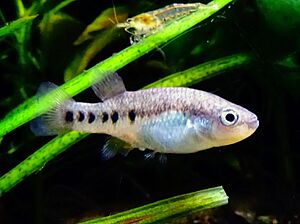Rainbow goodeid facts for kids
Quick facts for kids Rainbow goodeid |
|
|---|---|
 |
|
| Conservation status | |
| Scientific classification |
The rainbow goodeid (Characodon lateralis) is a small, colorful freshwater fish. It belongs to the family Goodeidae. These fish are special because they are found only in Mexico. You can find them in shallow springs and ponds in the areas of Durango and Coahuila. A scientist named Albert Günther first identified this fish in 1866. Sadly, the rainbow goodeid is now a critically endangered species, meaning it is at high risk of disappearing forever.
Contents
What Are Rainbow Goodeids Like?
Rainbow goodeids are small fish. Males are usually about 42 millimeters long, and females are a bit bigger, around 65 millimeters. This difference in size and looks between males and females is called sexual dimorphism.
Male Rainbow Goodeids
Male rainbow goodeids are often more colorful. They can have blue or green bodies with red parts and a shiny silver look. Their fins, which are called unpaired fins, can be yellow, black, or red. Males also have a special anal fin, called an andropodium. You might also see a black stripe near their anal fin.
Female Rainbow Goodeids
Female rainbow goodeids are not as colorful as the males. They usually have grey or green bodies with scales that you can almost see through. Instead of stripes, females often have a few oval-shaped spots on their front half, between their anal fin and the middle of their body.
How Rainbow Goodeids Reproduce
Rainbow goodeids have a unique way of having babies. Unlike many fish that lay eggs, the female rainbow goodeid keeps her babies inside her body. This is called viviparity, which means giving birth to live young. She also provides food and nutrients to the growing embryos inside her, similar to how mammals do. This is known as matrotrophy.
Females can start having babies when they are about five months old. They give birth to 5 to 20 baby fish, called fry, at a time. It takes about 55 days for the babies to grow inside the mother before they are born.
Where Rainbow Goodeids Live
The rainbow goodeid lives in freshwater, usually in shallow springs or marshy areas. They like places with slow-moving water or no current at all. They also prefer areas with lots of plants growing underwater. These fish are very sensitive to changes in their home.
Their Home in Mexico
These fish are found only in northern Mexico, mainly in the Durango and Coahuila regions. They like water with a pH between 6.0 and 8.0. They also prefer temperatures between 18°C and 27°C (about 64°F to 81°F). Their ideal home can have clear or slightly cloudy water. The bottom of their habitat can be sand, mud, silt, clay, rocks, or a type of soft rock called marl. They spend most of their time near the bottom of the pond or stream.
Sadly, many of the springs where they used to live have dried up. Also, their homes are often taken over by other types of fish and creatures that don't belong there. This means there are fewer good places for rainbow goodeids to live.
What Rainbow Goodeids Eat
Rainbow goodeids are herbivores, which means they mostly eat plants. Their main food source is algae. This is why they prefer springs that have a lot of plants growing underwater.
Why Rainbow Goodeids Need Our Help
The rainbow goodeid is a critically endangered species. This means their numbers are dropping fast, and they are at a very high risk of becoming extinct.
Main Threats to Their Survival
Many things threaten the rainbow goodeid:
- Other Species: New species of fish and crayfish are introduced into their homes. These new species either eat the rainbow goodeids or compete with them for food and space. Some examples are crayfish (Procambarus clarkii), Tilapia (Oreochromis neloticus), and Green Swordtails (Xiphophorus hellerii).
- Pollution: Water pollution from farms and city waste harms their habitat.
- Climate Change: Because they live in shallow water, their ponds and springs can dry up easily when the weather gets hotter or there's less rain. It's thought that their living area has shrunk by 65%!
- Human Activities: Things like building dams or too many people using the water can also hurt their homes.
What's Being Done to Help?
There aren't many big, organized efforts to save the rainbow goodeid right now. Some zoos and aquariums are trying to breed them in captivity. A university in Morelia, Mexico, has also started breeding programs to help increase their numbers.
Some people who love tropical fish also breed rainbow goodeids as a hobby. While this isn't an official conservation effort, it does help keep some of these special fish alive. Scientists are still trying to figure out exactly how many rainbow goodeids are left in the wild, which is hard to do.


